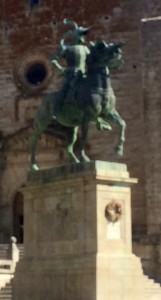15 October 2015
Myth
by Chin Chin

In the centre of the Spanish town of Trujillo there stands a large bronze statue of Francisco Pizarro, its most famous son. Pizarro was the leader of the expedition which conquered the Incas and annexed Peru to the Spanish crown, but he was only the first of the conquistadors to come from there. His brothers, and Orellana, and Alarcon, all were Trujillo men.
The odd thing about the statue is that it isn’t of Pizarro at all. Cast by the American sculptor Charles Rumsey as a statue of Cortes, it was offered to Mexico who declined it, Cortes not being one of their happier memories. With no other obvious home, it came to Trujillo where it was adopted as a statue of Pizarro instead. So, assuming that the sculptor did his research properly, we end up with an effigy of Cortes as Pizarro in much the same way as a theatrical statue might be of a great actor playing Othello.
It isn’t the only famous statue to depict the wrong man. In 2001, Winchester cathedral admitted that the statue which had stood for 37 years to commemorate the work of local hero, William Walker, a man who spent six years working by touch in diving gear to underpin the foundations of the building, was in fact an image of Francis Fox, the consulting engineer to the project. Apparently the sculptor had picked the wrong face out of a photograph. Anyway, the sculpture has now been replaced; but for a long time the public have gazed on what they thought was one man and seen another.
In classical statuary this must happen often. The archaeologist works with a pile of trunks, limbs and heads with no numbering system to guide him as he tries to fit them together. It must be hard enough to get the body parts to match, let alone to correctly identify the subject. Still, he wouldn’t be human if he didn’t have a go, so “probably Caesar” or “probably Augustus” will appear as the initial attribution. Give it a few years and any resemblance, and the “probably” bit will gradually drop. How many museums own a statue of Augustus which is really just a statue of someone who happened to look like him with the left arm of a centaur?
Before we begin to feel sorry for Pizarro and others who go down in history as looking rather different from the way they actually did, it is worth a glance in the mirror. Would we really like an exact image of ourselves to be passed on to posterity, or would we rather that it was, well, airbrushed a little bit?
“I only like to be photographed from the right side” you say, leaving future generations with the false impression that the left side was equally attractive. Or even “Perhaps I could pull the brim of the hat down – like Cary Grant playing a detective.”
“Was great great granddad in MI5?” you secretly hope your descendants will ask.
“Well, he was supposed to be a chartered accountant, dear, but looking at the picture I expect that was only cover.” Job done. Myth created.
Of course, it isn’t only posterity which we try to fool with our illusions. Even if “no man is a hero to his valet” (as we are assured by Mme Cornuel), that leaves quite a range of human beings to practice upon, and practice we surely do: an interested smile when that very pretty girl explains her rather foolish theories; an expression of deep respect when we hear the same nonsense being spouted by our rich elderly uncle; an expression of scepticism when we hear someone we dislike propound a perfectly sound theory (and the more contemptuous the sneer, the more likely we are to use the theory ourselves on the morrow). All the world may be a stage, but the role of the players is more than Shakespeare suggests. They do not just play their parts. They also write the lines.
In the minefield world of sexual relationships, myth-making has quite a different significance. We are often reminded that sex without consent amounts to rape, and of course consent can hardly be real consent if it is procured by deception. Here the myth-maker has to be careful. “I really want a long term relationship”, “I so enjoyed meeting your family”, “I am in line for a good job”, “My cooking is much admired,” “It’s your mind I admire, not just your body,” “I think you have a nice face,” “I’d like you just as much if you were poor”, “I am unmarried/rich/quick thinking/affectionate/fond of cheese/a dog lover/under 30/of good character/related to the Archbishop of Canterbury.” All are the common currency of seduction and yet not always, in every case, true. When computers learn to read our inmost thoughts, the rape police are going to be busy people.
Still, the greatest risk posed by the illusions which we create is not that we get found out but that we become so wrapped up in them that we forget who we are. Once upon a time a great actor was invited out to lunch. It was to be a glittering occasion with a mixture of the crowned heads and political leaders of Europe and he was anxious not to let his host down; so he rang up to ask how he should dress. On being told that a lounge suit would be fine, he hesitated and then said to his host:
“What I would really like to understand is who I should come as.”
Compared to him, Pizarro got off lightly.

